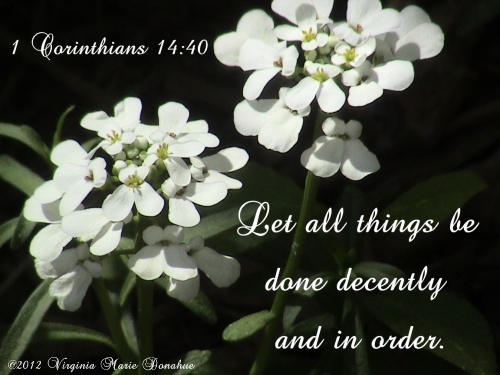
This is why such structure begins to manifest itself rather quickly when the New Testament church, at the initiative of the congregation at Jerusalem, already convenes in Acts 15 for what is called the Council or Synod of Jerusalem. Since the New Testament church is the mature outgrowth of the “church in the wilderness” (Acts 7:38), such divinely initiated orderliness must be her hallmark as well. This orderliness was visible in the congregation of Israel during her lengthy journey through the wilderness the Tabernacle, God’s visible dwelling place in the midst of His people, was at the very center of this organizational structure, and every tribe of this congregation had its proper and divinely appointed location in reference to the Tabernacle. Therefore God’s supreme spiritual accomplishment, the church of His beloved Son, will manifest the same orderly structure that we observe in all the works of His hands. Orderliness is characteristic of all the works of God. Paul emphasizes this when he writes in the same chapter, “For God is not the author of confusion, but of peace, as in all churches of the saints” (1 Cor. The church of the Lord Jesus Christ must function in an orderly fashion, for God is a God of order. This realization prompted him to ordain elders whenever new churches were established. Paul recognized that the church can only function well when managed in an orderly fashion. The foundation for the orderly functioning of the church is found in 1 Corinthians 14:40, “Let all things be done decently and in order.” These words conclude a lengthy exhortation from the Apostle Paul to a congregation with more disorder than order. Upon examining our Church Order more closely, we will find an organizational structure tailor-made to protect and foster the well-being of the body of the Lord Jesus Christ.


This means that the rules governing church life must be uniquely suited to foster the growth and health of this living organism. This would be applicable to the church as well – with the understanding, however, that rather than viewing the church as an organization, we should view her as a living organism, the living body of the Lord Jesus Christ (1 Cor. Hardly anyone would argue the point that the proper functioning of any organization will be proportionate to its organizational structure. We refer to these rules as the Church Order of Dort.Īs the term “Church Order” indicates, these rules have been formulated and adopted by the church to facilitate the orderly functioning of the church locally and denominationally.

Most of us are aware that our federation of churches (or denomination) functions in accordance with a specific set of rules, and that each congregation within our denomination is obligated to honor and implement these rules.


 0 kommentar(er)
0 kommentar(er)
